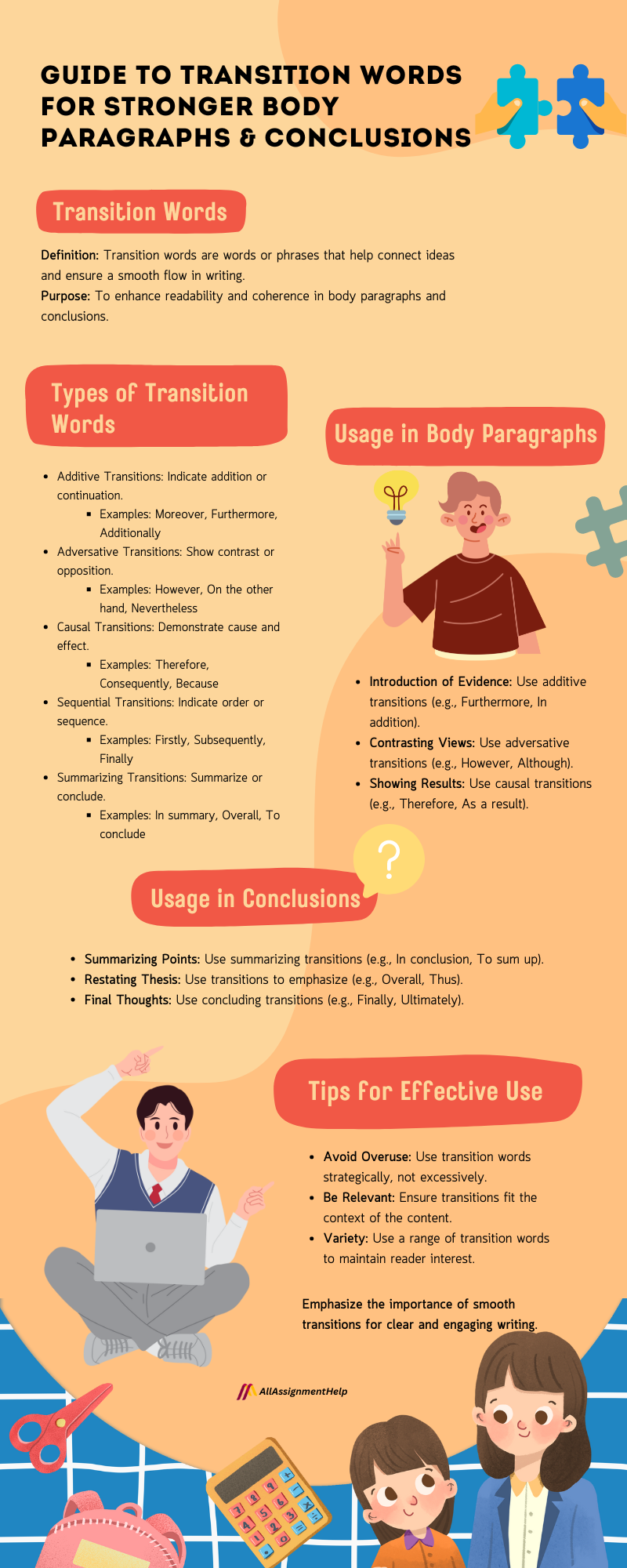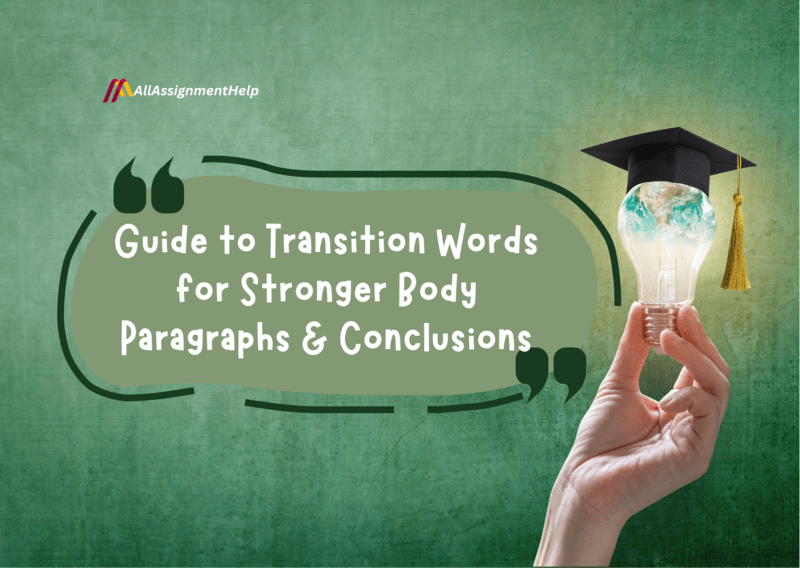Table of Contents
Presenting ideas in a clear and intelligible manner is one of your main objectives as a writer. You should carefully consider how to organize your paper both overall and in the individual paragraphs that make up the document to facilitate readers to navigate through your intricate concepts. Moreover, using transition words in specific sentences might help readers understand the connections you are making.
Nevertheless, the main method of achieving clear writing is the purposeful arrangement of your thoughts throughout your entire work. Transitional words and phrases can strengthen the connections between your thoughts and help the reader understand the logic of your work. Through this blog article by All Assignment Help, let us learn about transition words, their usage, and examples in depth.
Understanding Transition Words
Definition
Transition words help to make sense-filled connections between ideas. Moreover, writers should deliberately and carefully choose the words and phrases that best match the specific situation or aim of their writing because concepts can be related to one another in a variety of ways.
Purpose
You can improve the content’s readability by using transitional terms in your writing. They improve text flow and make paragraphs and sentences clear to readers.
Types of transitions
Depending on the kind of link you wish to make, transition words can be categorized into multiple groups. For a single transition, there are frequently multiple terms available. Sometimes they signify the exact same thing, while other times they differ just a little. Some common types of transition are cause and effect, clarification, contrast, example, emphasis, enumeration, time, similarity, and summarize/conclusion.
Also read: Simple Yet Significant Things to Remember About Transition Words for Compare and Contrast Essay
Using Transition Words in Body Paragraphs
The aim of within-paragraph transitions is to notify readers of upcoming changes in viewpoint or tone, whereas the distinctive function of between-paragraph transitions is to notify readers of upcoming changes in argument or concept. Within an academic essay, shifts in argument or concept typically occur between paragraphs because one of the fundamental principles of efficient paragraph writing is to limit each paragraph to a single controlling topic.
Although there are numerous strategies you might use, let us examine some fundamental guiding questions you ought to be asking yourself when you review your own work and draft your own transitions between paragraphs:
- What does this paragraph aim to accomplish? Is it to provide background information, provide a case, address a divergent opinion, or emphasize or rephrase previously mentioned points?
- Is there a connection between the notion I am expressing in this paragraph and any other idea or argument made in the essay so far?
- Does the concept I am putting forward here offer an alternative perspective?
- Does the concept I am presenting stand alone or is it dependent on other ideas discussed in the essay?
The answers you provide to these four simple questions should make it easier for you to choose which types of transition words would be most appropriate to use at the start of each of your paragraphs. However, if you are still confused then try connecting to assignment help online services for a well-written assignment or essay that follows the transition rules carefully.
Example
To begin with, one should realize the importance of time management for academic success. Moreover, proper time management helps students organize the task and relieve pressure on them hence enhancing academic performance. However, regardless of its advantages, time management is also something many students struggle with. On the other hand, there are several approaches to overcome this hurdle. For instance, methods such as using planners, and setting smart goals can contribute to motivation in verbal skills. Nevertheless, as helpful as these can be, they will not stop students from experiencing things like emergency situations or being overworked. In contrast, individuals who try to maintain a timetable usually adapt better to challenges as they reach their aim of excelling in academics more promptly. In short, time management is a fundamental life skill that everyone must be proficient at to achieve success academically and personally.
Also read: Ways to Become an Expert in Professional Writing

Effective Use of Transition Words in Body Paragraphs
Given below are some transition words that you can effectively use in body paragraphs.
First body paragraph:
- To begin with: Refers to the first argument or point that is made and indicates where it all begins.
- Firstly: Showing an introductory point or reason.
- The first point is: The initial position or evidence in your essay is introduced clearly with this.
- In the first place: Used to emphasize that this is the primary or initial reason.
- Initially: Implies that it is the first idea in a series.
- First and foremost: Emphasizes the most important point in a list.
- One major aspect is: Introduces a key point or factor in the argument.
- The primary consideration is: Makes clear that it is the most important thing to consider.
Second body paragraph:
- Secondly: Introduces the second point, showing that it follows logically from the first.
- In addition: Adds another point that supports the argument, and also claims a cost of evidence that leads to the argument.
- Furthermore: It adds new arguments or evidence to the previous response.
- Another important point is: It introduces a new but equally significant argument.
- Moreover: Takes the preceding point and emphasizes or draws attention to its importance.
- The next aspect to consider is: It guides the reader into the next essential detail or part of your argument.
- Building on that: Demonstrates the new point is a development or extension of an earlier point.
- On the other hand: Offers an opposite viewpoint.
- Equally important: This tells the reader that the next point is just as big, if not bigger than what you just mentioned.
Third body paragraph:
- Finally: Introduce the last point, signalling that it is the final part of your argument.
- In the final analysis: Summarize the entire conversation and lead into the concluding argument.
- The last point is: It shows the final argument or evidence directly.
- Lastly: Like finally, it is the last idea or point in your essay.
- In conclusion: Indicates that you are wrapping up the essay, with a lead into your final point(s).
- To conclude: Another way to write a conclusion, which is the final thoughts or summary of an essay.
- The final aspect is: Conclusion; which highlights its overall significance.
- Ultimately: Conveys that this is the final, overall takeaway from the essay.
- In summary: Summarizes the main points of your essay, often before the conclusion.
Also read: Your Guide Towards Writing an Outstanding Short Essay
Strengthening Conclusions with Transition Words
You should alert the reader to the upcoming conclusion when you reach the end of a section or the entire document. Moreover, a closing transition should often be used either in:
- the beginning of the last paragraph in a section or work.
- the final phrase in a section or paper’s concluding paragraph.
It goes without saying that using a term like “in summary” means you will be summarizing the points you have already covered in the article. Try using “finally” to imply a strong sense of finality and to indicate the conclusion of the discussion. Furthermore, if your essay or article dealt with a story that developed over time, you may want to end it with “in the end” to give the reader a sense of closure.
Now you know how significant it is to use transition words in academic writing to improve the flow and clarity of a write-up. However, for students, it can be challenging to master the art of using transition words, especially in complex assignments. As a result, students would want to ease their academic workload through online class help services or academic assignment writing services. By doing so, students can learn the intricacies of writing without stressing about their assignments, online courses, or other academic responsibilities.
Effective Use of Transition Words in Conclusion Paragraph
Given below are some transition words that you can effectively use in the conclusion paragraph.
- In conclusion: Brief summary of the arguments or series of musings that formed this essay.
- To conclude: Just like “in conclusion,” to signal to readers that the essay is over and to present your last recap or idea.
- Ultimately: Highlights the conclusion of a story or series, after all other information has been assessed.
- In summary: Gives a brief summary of the major points discussed in the essay.
- To summarize: Summarizes the base arguments into a concise closure of the essay.
- In the final analysis: Used to introduce the final decision after everything has been considered.
- All things considered: Reflects on all aspects discussed and leads to a general conclusion.
- Given these points: Summarizes the discussion picking out main points taken throughout which leads to an ending conclusion.
- As a result: Shows the effect or result of an action taken by the author in his essay.
- Thus: Suggests a logical consequence of what has been stated.
- Therefore: Implies that the conclusion follows logically from the preceding discussion.
- Hence: It signifies a conclusion resulting from the arguments yet used similarly as therefore.
- Consequently: Shows that the conclusion is a direct result of the arguments made in the essay.
- Overall: Provides a general summary of the entire essay, emphasizing the overall conclusion.
- In essence: Summarize the motto of your essay.
- In brief: Summaries the main takeaways and final thoughts.
- In short: Like “in brief,” it summarizes the entire essay and hints at a final thought.
- On the whole: Indicates a general evaluation or conclusion being drawn from the argument as a whole.
In addition to this, you can seek assistance from an assignment helper if you are unable to master the skill of using transition words in paragraphs.
Conclusion
Using transition words correctly can help guarantee that your arguments are consistently supported. This alone will improve the quality and integrity of many ‘average’ writings! Suppose you understand how to use them in body paragraphs and conclusions. In that case, your connections will seem smoother and more natural, making it easier for the reader to follow the story or dialogue. The motto to remember is balance; use transitions that enrich the writing without overshadowing it. Once you have honed these skills, the right transitions can help lift your work from decent to brilliant, leaving well-organized articles that may inspire others.
Frequently Asked Questions
| Question: How would you begin your first paragraph? Answer: A word or two (although, for example, similarly), a phrase or a sentence might serve as a transition between paragraphs. Moreover, transitions can occur in both the first and second paragraphs or at the end of the first paragraph. |
| Question: What makes a good introduction sentence? Answer: A strong hook could be a claim or a question, or anything that will cause the reader to feel something. Consider this, what you want to say but do not think you can express is what makes a strong starting statement. |
